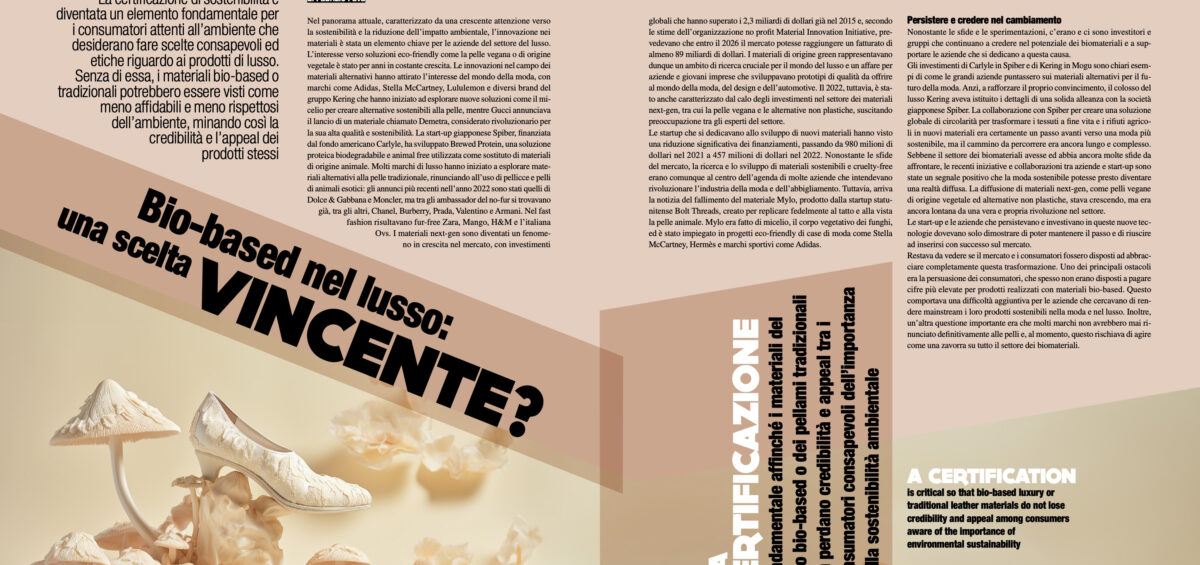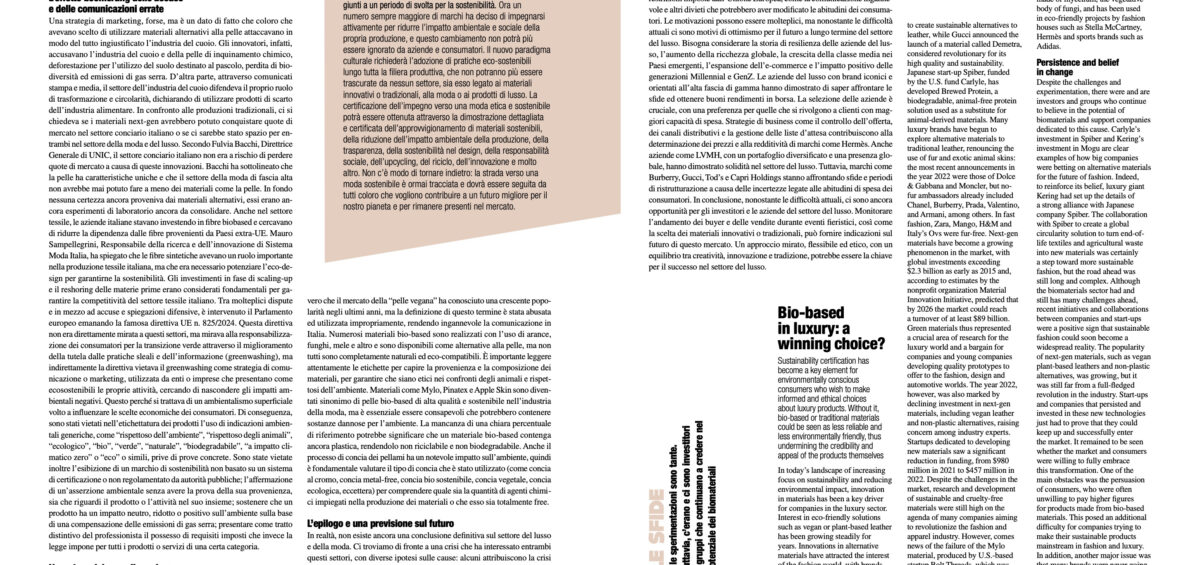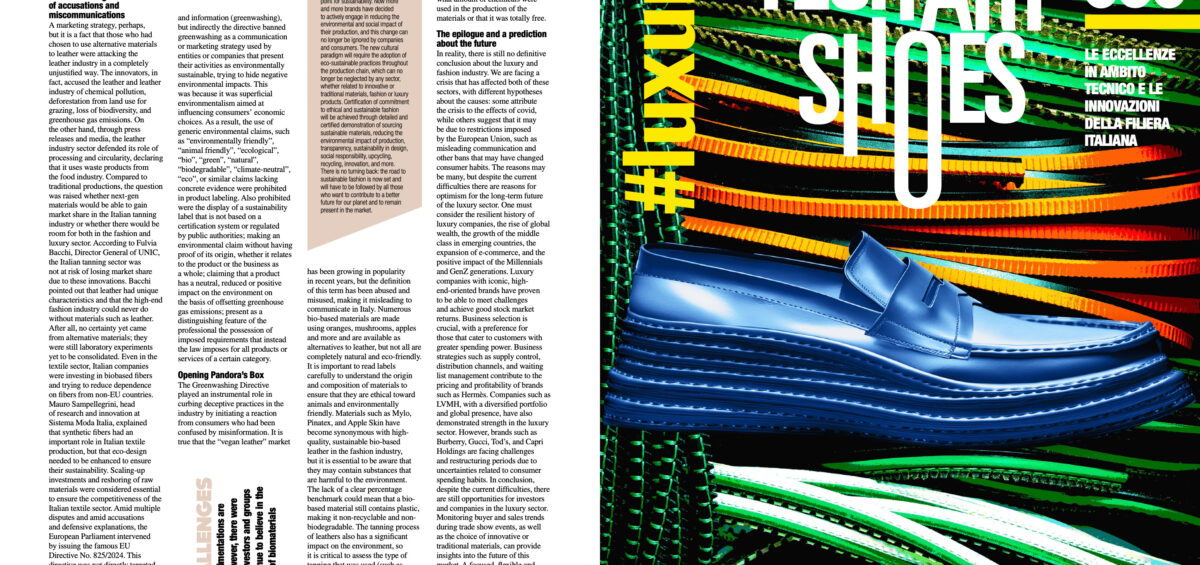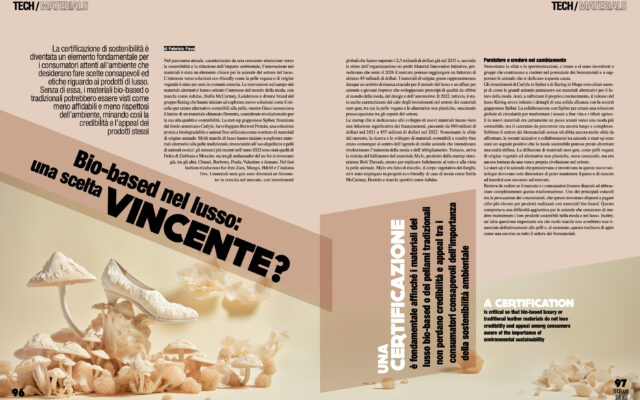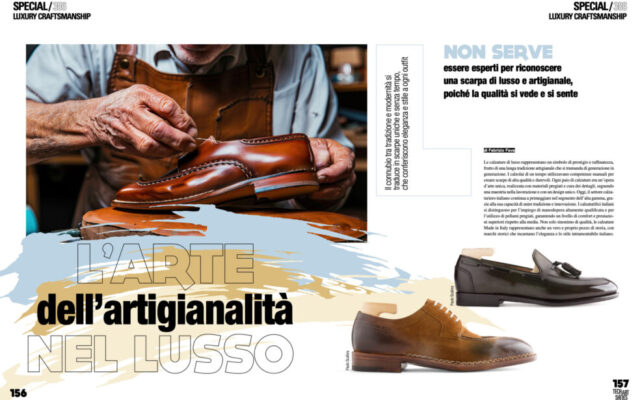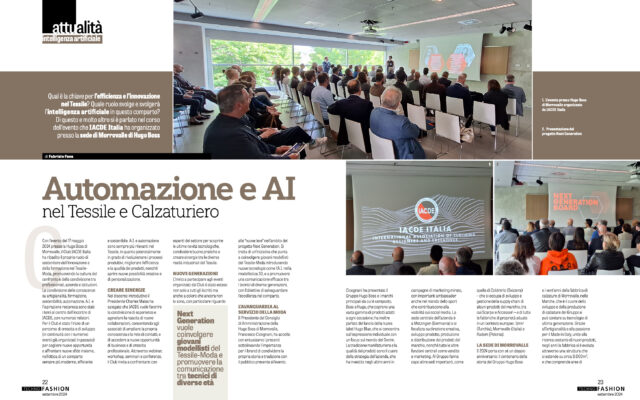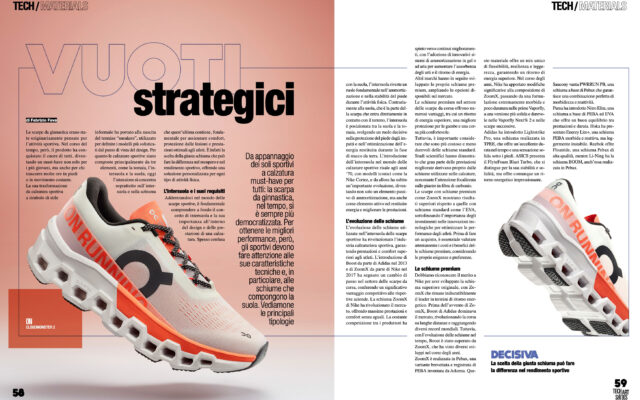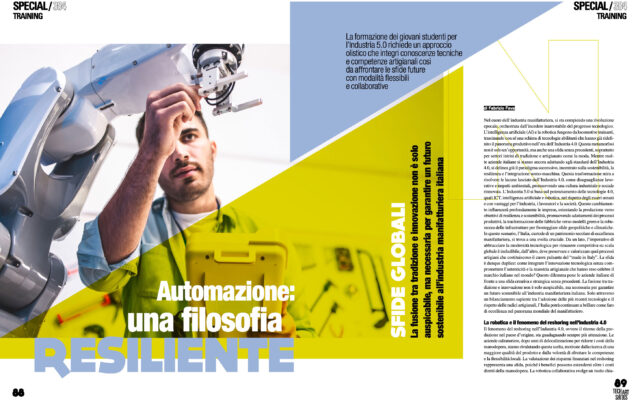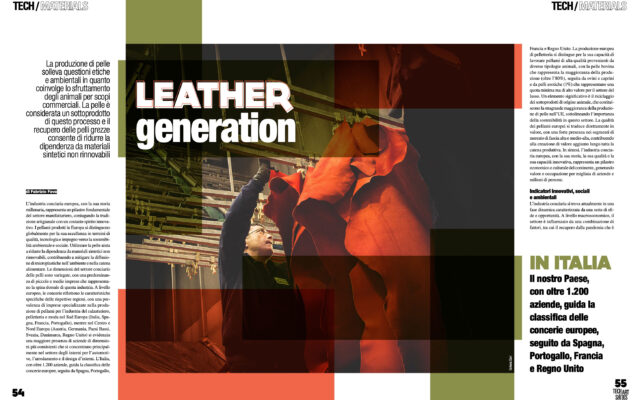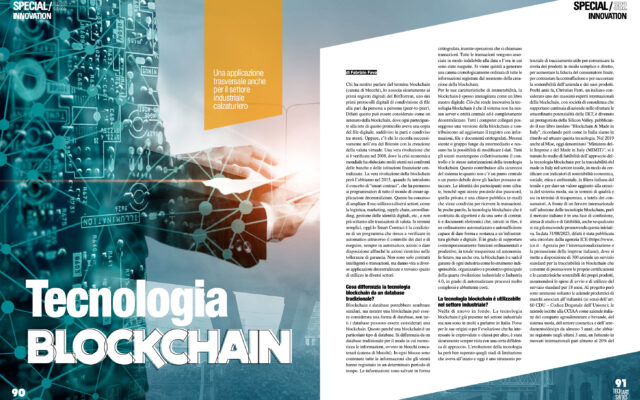Bio-based nel Lusso: una scelta vincente?
Tech Art Shoes - settembre 2024
Bio-based nel Lusso: una scelta vincente?
Nel panorama attuale, caratterizzato da una crescente attenzione verso la sostenibilità e la riduzione dell’impatto ambientale, l’innovazione nei materiali è stata un elemento chiave per le aziende del settore del lusso. L’interesse verso soluzioni eco-friendly come la pelle vegana o di origine vegetale è stato per anni in costante crescita. Le innovazioni nel campo dei materiali alternativi bio-based hanno attirato l’interesse del mondo della moda, con marchi come Adidas, Stella McCartney, Lululemon e diversi brand del gruppo Kering che hanno iniziato ad esplorare nuove soluzioni come il micelio per creare alternative sostenibili alla pelle, mentre Gucci annunciava il lancio di un materiale chiamato Demetra, considerato rivoluzionario per la sua alta qualità e sostenibilità. La start-up giapponese Spiber, finanziata dal fondo americano Carlyle, ha sviluppato Brewed Protein, una soluzione proteica biodegradabile e animal free utilizzata come sostituto di materiali di origine animale. Molti marchi di lusso hanno iniziato a esplorare materiali alternativi alla pelle tradizionale, rinunciando all’uso di pellicce e pelli di animali esotici: gli annunci più recenti nell’anno 2022 sono stati quelli di Dolce & Gabbana e Moncler, ma tra gli ambassador del no-fur si trovavano già, tra gli altri, Chanel, Burberry, Prada, Valentino e Armani. Nel fast fashion risultavano fur-free Zara, Mango, H&M e l’italiana Ovs. I materiali next-gen sono diventati un fenomeno in crescita nel mercato, con investimenti globali che hanno superato i 2,3 miliardi di dollari già nel 2015 e secondo le stime dell’organizzazione no profit “Material Innovation Initiative” prevedevano che entro il 2026 il mercato potesse raggiungere un fatturato di almeno 89 miliardi di dollari. I materiali di origine green rappresentavano dunque un ambito di ricerca cruciale per il mondo del lusso ed un affare per aziende e giovani imprese che sviluppavano prototipi di qualità da offrire al mondo della moda, del design e dell’automotive. Il 2022, tuttavia, è stato anche caratterizzato dal calo degli investimenti nel settore dei materiali next-gen, tra cui la pelle vegana e le alternative non plastiche, suscitando preoccupazione tra gli esperti del settore. Le startup che si dedicavano allo sviluppo di nuovi materiali, hanno visto una riduzione significativa dei finanziamenti, passando da 980 milioni di dollari nel 2021 a 457 milioni di dollari nel 2022. Nonostante le sfide del mercato, la ricerca e lo sviluppo di materiali sostenibili e cruelty-free erano comunque al centro dell’agenda di molte aziende che intendevano rivoluzionare l’industria della moda e dell’abbigliamento. Tuttavia, arriva la notizia del fallimento del materiale Mylo, prodotto dalla startup statunitense Bolt Threads, creato per replicare fedelmente al tatto e alla vista la pelle animale. Mylo era fatto di micelio, il corpo vegetativo dei funghi, ed è stato impiegato in progetti eco-friendly di case di moda come Stella McCartney, Hermès e marchi sportivi come Adidas.
Persistere e credere nel cambiamento nel Bio-based
Nonostante le sfide e le sperimentazioni, c’erano e ci sono investitori e gruppi che continuano a credere nel potenziale dei biomateriali e a supportare le aziende che si dedicano a questa causa. Gli investimenti di Carlyle in Spiber e di Kering in Mogu sono chiari esempi di come le grandi aziende puntassero sui materiali alternativi per il futuro della moda. Anzi, a rafforzare il proprio convincimento, il colosso del lusso Kering aveva istituito i dettagli di una solida alleanza con la società giapponese Spiber. La collaborazione con Spiber per creare una soluzione globale di circolarità per trasformare i tessuti a fine vita e i rifiuti agricoli in nuovi materiali era certamente un passo avanti verso una moda più sostenibile, ma il cammino da percorrere era ancora lungo e complesso. Sebbene il settore dei biomateriali avesse ed abbia molte sfide da affrontare, le recenti iniziative e collaborazioni tra aziende e start-up sono state un segnale positivo che la moda sostenibile potesse presto diventare una realtà diffusa. La diffusione di materiali next-gen, come pelli vegane di origine vegetale ed alternative non plastiche, stava crescendo, ma era ancora lontana da una vera e propria rivoluzione nel settore. Le start-up e le aziende che persistevano ed investivano in queste nuove tecnologie dovevano solo dimostrare di poter mantenere il passo e di riuscire ad inserirsi con successo sul mercato. Restava da vedere se il mercato ed i consumatori fossero disposti ad abbracciare completamente questa trasformazione. Uno dei principali ostacoli era la persuasione dei consumatori, che spesso non erano disposti a pagare cifre più elevate per prodotti realizzati con materiali bio-based. Questo comportava una difficoltà aggiuntiva per le aziende che cercavano di rendere mainstream i loro prodotti sostenibili nella moda e nel lusso. Inoltre, un’altra questione importante era che molti marchi non avrebbero mai rinunciato definitivamente alle pelli e, al momento, questo rischiava di agire come una zavorra su tutto il settore dei biomateriali.
L’effetto boomerang delle accuse e delle comunicazioni errate.
Una strategia di marketing, forse, ma è un dato di fatto che coloro che avevano scelto di utilizzare materiali alternativi alla pelle attaccavano in modo del tutto ingiustificato l’industria del cuoio. Gli innovatori, infatti, accusavano l’industria del cuoio e della pelle di inquinamento chimico, deforestazione per l’utilizzo del suolo destinato al pascolo, perdita di biodiversità ed emissioni di gas serra. D’altra parte, attraverso comunicati stampa e media, il settore dell’industria del cuoio difendeva il proprio ruolo di trasformazione e circolarità, dichiarando di utilizzare prodotti di scarto dell’industria alimentare. In confronto alle produzioni tradizionali, ci si chiedeva se i materiali next-gen avrebbero potuto conquistare quote di mercato nel settore conciario italiano o se ci sarebbe stato spazio per entrambi nel settore della moda e del lusso. Secondo Fulvia Bacchi, direttrice generale di UNIC, il settore conciario italiano non era a rischio di perdere quote di mercato a causa di queste innovazioni. Bacchi ha sottolineato che la pelle ha caratteristiche uniche e che il settore della moda di fascia alta non avrebbe mai potuto fare a meno dei materiali come la pelle. In fondo nessuna certezza ancora proveniva dai materiali alternativi, essi erano ancora esperimenti di laboratorio ancora da consolidare. Anche nel settore tessile, le aziende italiane stavano investendo in fibre biobased e cercavano di ridurre la dipendenza dalle fibre provenienti da Paesi extra-UE. Mauro Sampellegrini, responsabile della ricerca e dell’innovazione di Sistema Moda Italia, ha spiegato che le fibre sintetiche avevano un ruolo importante nella produzione tessile italiana, ma che era necessario potenziare l’eco-design per garantirne la sostenibilità. Gli investimenti in fase di scaling-up e il reshoring delle materie prime erano considerati fondamentali per garantire la competitività del settore tessile italiano. Tra molteplici dispute ed in mezzo ad accuse e spiegazioni difensive, è intervenuto il Parlamento europeo emanando la famosa direttiva UE n. 825/2024. Questa direttiva non era direttamente mirata a questi settori, ma mirava alla responsabilizzazione dei consumatori per la transizione verde attraverso il miglioramento della tutela dalle pratiche sleali e dell’informazione (Greenwashing), ma indirettamente la direttiva vietava il greenwashing come strategia di comunicazione o marketing, utilizzata da enti o imprese che presentano come ecosostenibili le proprie attività, cercando di nascondere gli impatti ambientali negativi. Questo perché si trattava di un ambientalismo superficiale volto ad influenzare le scelte economiche dei consumatori. Di conseguenza sono stati vietati, nell’etichettatura dei prodotti, l’uso di indicazioni ambientali generiche, come “rispettoso dell’ambiente”, “rispettoso degli animali”, “ecologico”, “bio”, “verde”, “naturale”, “biodegradabile”, “a impatto climatico zero” o “eco” o simili, prive di prove concrete. Sono state vietate inoltre l’esibizione di un marchio di sostenibilità non basato su un sistema di certificazione o non regolamentato da autorità pubbliche; l’affermazione di un’asserzione ambientale senza avere la prova della sua provenienza, sia che riguardi il prodotto o l’attività nel suo insieme; sostenere che un prodotto ha un impatto neutro, ridotto o positivo sull’ambiente sulla base di una compensazione delle emissioni di gas serra; presentare come tratto distintivo del professionista il possesso di requisiti imposti che invece la legge impone per tutti i prodotti o servizi di una certa categoria.
L’apertura del vaso di pandora.
La direttiva sul Greenwashing ha giocato un ruolo determinante nel mettere un freno alle pratiche ingannevoli nel settore, avviando una reazione da parte dei consumatori che erano stati confusi da informazioni sbagliate. È vero che il mercato della “pelle vegana” ha conosciuto una crescente popolarità negli ultimi anni, ma la definizione di questo termine è stata abusata ed utilizzata impropriamente, rendendo ingannevole la comunicazione in Italia. Numerosi materiali bio-based sono realizzati con l’uso di arance, funghi, mele e altro e sono disponibili come alternative alla pelle, ma non tutti sono completamente naturali ed eco-compatibili. È importante leggere attentamente le etichette per capire la provenienza e la composizione dei materiali, per garantire che siano etici nei confronti degli animali e rispettosi dell’ambiente. Materiali come Mylo, Pinatex e Apple Skin sono diventati sinonimo di pelle bio-based di alta qualità e sostenibile nell’industria della moda, ma è essenziale essere consapevoli che potrebbero contenere sostanze dannose per l’ambiente. La mancanza di una chiara percentuale di riferimento potrebbe significare che un materiale bio-based contenga ancora plastica, rendendolo non riciclabile e non biodegradabile. Anche il processo di concia dei pellami ha un notevole impatto sull’ambiente, quindi è fondamentale valutare il tipo di concia che è stato utilizzato (come concia al cromo, concia metal-free, concia bio sostenibile, concia vegetale, concia ecologica, ecc.) per comprendere quale sia la quantità di agenti chimici impiegati nella produzione dei materiali o che esso sia totalmente free.
…da qui, non si torna indietro.
A quasi fine anno 2024, siamo finalmente giunti a un periodo di svolta per la sostenibilità. Ora un numero sempre maggiore di marchi ha deciso di impegnarsi attivamente per ridurre l’impatto ambientale e sociale della propria produzione, e questo cambiamento non potrà più essere ignorato da aziende e consumatori. Questo nuovo paradigma culturale richiederà l’adozione di pratiche eco-sostenibili lungo tutta la filiera produttiva, che non potranno più essere trascurate da nessun settore, che sia legato ai materiali innovativi o tradizionali, alla moda o ai prodotti di lusso. La certificazione dell’impegno verso una moda etica e sostenibile potrà essere ottenuta attraverso la dimostrazione dettagliata e certificata dell’approvvigionamento di materiali sostenibili, della riduzione dell’impatto ambientale della produzione, della trasparenza, della sostenibilità nel design, della responsabilità sociale, dell’upcycling, del riciclo, dell’innovazione e molto altro. Non c’è modo di tornare indietro: la strada verso una moda sostenibile è ormai tracciata e dovrà essere seguita da tutti coloro che vogliono contribuire ad un futuro migliore per il nostro pianeta e per rimanere presenti nel mercato.
…L’epilogo e una previsione sul futuro.
In realtà, non esiste ancora una conclusione definitiva sul settore del lusso e della moda. Ci troviamo di fronte ad una crisi che ha interessato entrambi questi settori, con diverse ipotesi sulle cause: alcuni attribuiscono la crisi agli effetti del Covid, mentre altri suggeriscono che possa essere dovuta alle restrizioni imposte dall’Unione Europea, come la comunicazione ingannevole ed altri divieti che potrebbero aver modificato le abitudini dei consumatori. Le motivazioni possono essere molteplici, ma nonostante le difficoltà attuali, ci sono motivi di ottimismo per il futuro a lungo termine del settore del lusso. Bisogna considerare la storia di resilienza delle aziende del lusso, l’aumento della ricchezza globale, la crescita della classe media nei Paesi emergenti, l’espansione dell’e-commerce e l’impatto positivo delle generazioni Millennials e Gen Z. Le aziende del lusso con brand iconici ed orientati all’alta fascia di gamma hanno dimostrato di saper affrontare le sfide ed ottenere buoni rendimenti in borsa. La selezione delle aziende è cruciale, con una preferenza per quelle che si rivolgono a clienti con maggiori capacità di spesa. Strategie di business come il controllo dell’offerta, dei canali distributivi e la gestione delle liste d’attesa contribuiscono alla determinazione dei prezzi ed alla redditività di marchi come Hermès. Anche aziende come LVMH, con un portafoglio diversificato e una presenza globale, hanno dimostrato solidità nel settore del lusso. Tuttavia, marchi come Burberry, Gucci, Tod’s e Capri Holdings stanno affrontando sfide e periodi di ristrutturazione a causa delle incertezze legate alle abitudini di spesa dei consumatori. In conclusione, nonostante le difficoltà attuali, ci sono ancora opportunità per gli investitori e le aziende del settore del lusso. Monitorare l’andamento dei buyer e delle vendite durante eventi fieristici, così come la scelta dei materiali innovativi o tradizionali, può fornire indicazioni sul futuro di questo mercato. Un approccio mirato, flessibile ed etico, con un equilibrio tra creatività, innovazione e tradizione, potrebbe essere la chiave per il successo nel settore del lusso.

